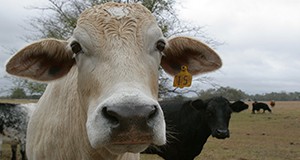 The efficiency of post-weaning development of heifers has a major impact on the overall profitability of cow-calf operations. To ensure satisfactory performance during the first breeding season, replacement heifers must be subjected to an adequate development program. This 3-page fact sheet covers age at puberty, nutrition, target body weight gain, pelvic area measurements, reproductive tract score, and herd health. Written by Pedro L. P. Fontes, Nicky Oosthuizen, Carla D. Sanford, and G. Cliff Lamb, and published by the UF Department of Animal Sciences, November 2016.
The efficiency of post-weaning development of heifers has a major impact on the overall profitability of cow-calf operations. To ensure satisfactory performance during the first breeding season, replacement heifers must be subjected to an adequate development program. This 3-page fact sheet covers age at puberty, nutrition, target body weight gain, pelvic area measurements, reproductive tract score, and herd health. Written by Pedro L. P. Fontes, Nicky Oosthuizen, Carla D. Sanford, and G. Cliff Lamb, and published by the UF Department of Animal Sciences, November 2016.
http://edis.ifas.ufl.edu/an329
Tag: Nicky Oosthuizen
Estrous Synchronization and Fixed-Time Artificial Insemination
 The economic success of beef cow-calf operations depends on the production of one healthy calf per cow per year. To achieve this goal, cow-calf producers need to overcome several obstacles related to the cow, bull, and offspring. Over the last four decades, several advances in reproductive biotechnologies, such as artificial insemination (AI), synchronization of estrus, and fixed-time AI (TAI), have allowed producers to improve the genetic traits of their cattle and shorten the lengths of both the breeding season and subsequent calving season, which can lead to increased overall profitability of cow-calf production systems. This 5-page fact sheet discusses benefits of synchronization and TAI use, obstacles that hinder adoption of reproductive biotechnologies, objectives of the Beef Reproduction Task Force, and factors that can affect the success of TAI programs. Written by Vitor R. G. Mercadante, Darren D. Henry, Francine M. Ciriaco, Pedro L. P. Fontes, Nicky Oosthuizen, and G. Cliff Lamb, and published by the UF Department of Animal Sciences, January 2016.
The economic success of beef cow-calf operations depends on the production of one healthy calf per cow per year. To achieve this goal, cow-calf producers need to overcome several obstacles related to the cow, bull, and offspring. Over the last four decades, several advances in reproductive biotechnologies, such as artificial insemination (AI), synchronization of estrus, and fixed-time AI (TAI), have allowed producers to improve the genetic traits of their cattle and shorten the lengths of both the breeding season and subsequent calving season, which can lead to increased overall profitability of cow-calf production systems. This 5-page fact sheet discusses benefits of synchronization and TAI use, obstacles that hinder adoption of reproductive biotechnologies, objectives of the Beef Reproduction Task Force, and factors that can affect the success of TAI programs. Written by Vitor R. G. Mercadante, Darren D. Henry, Francine M. Ciriaco, Pedro L. P. Fontes, Nicky Oosthuizen, and G. Cliff Lamb, and published by the UF Department of Animal Sciences, January 2016.
http://edis.ifas.ufl.edu/an324